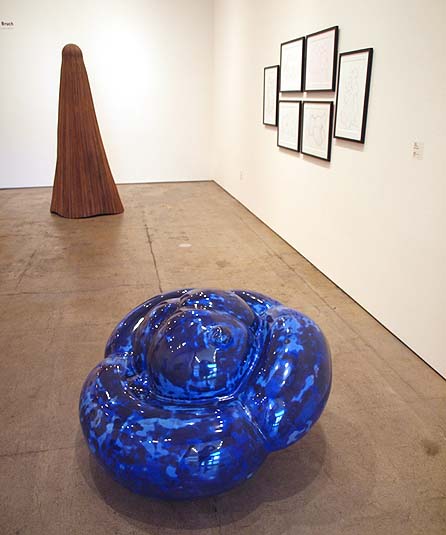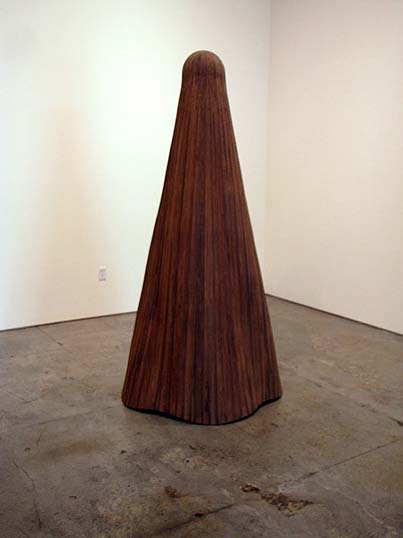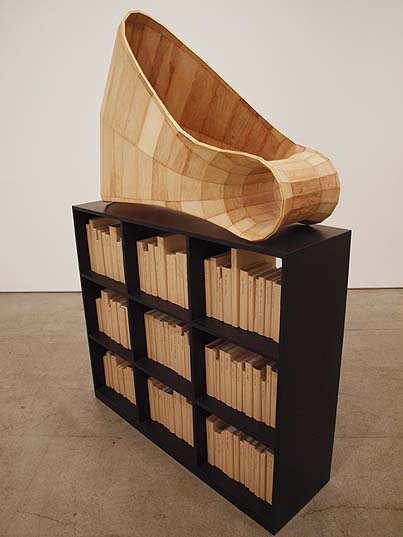
|
||
|
Portland art blog + news + exhibition reviews + galleries + contemporary northwest art
|
||
Cris Bruch at Elizabeth Leach Gallery 
Cris Bruch’s exhibition, Gather and Wait at Elizabeth Leach Gallery, seduces with meticulous craft and sensuous forms that are nevertheless familiar. For anyone with a modicum of exposure to modern art, many of his sculpture call up the name of another artist, Martin Puryear, whose work has made this style of abstraction iconic. Associations can be made with Richard Rezac’s work as well; yet similarities can always be found between artists working with a particular material, and no single artist holds a monopoly on subject matter or form. It is what each artist does with the material and ideas that is ultimately judged. In 2007, a twenty-year survey of Bruch’s work, How Did I Get Here?, at Lawrimore Project in Seattle, solidified his position as a major artistic voice in the Northwest. Initially known for his more performance-based sculptural work, early on he was seen as more of a talented curiosity with a decidedly political narrative than the commissioned abstract artist that he has become today. Yet, even with the recent survey, images of his earliest work were missing from the numerous reviews and articles in the Leach Gallery press package, and aside from a somewhat cynical remark by one writer about money, nor was there a sufficient rationale given for Bruch’s move from the politicized to the abstract. However, Bruch’s website provided some insight: In the 1990's, Bruch's work began to integrate issues of consumer culture and social/economic disparity with a more formal aesthetic, characterized by the use of non-traditional materials and repetitive processes. This work was informed by an awareness of the unconscious, oft-repeated actions that, to one degree or another, form our lives and define who we are. The described process of making is clearly perceived in the work, yet as what may be a hallmark of the unconscious, the motivations are less clear. While all of the sculptures involve a certain repetitive process or a number of processes, all must certainly require a very present, precise and patient mind. More a meditation than dream, the final pieces may inspire a psychic response, yet the precision involved, particularly in some of the wooden structures, calls to mind elaborations of mathematic and geometric equations. 
Blind (2010) This observation takes nothing away from the work itself; nor is it meant to suggest that a narrative is absent as inspiration, for some of the work is figurative, which may very well spring from the unconscious. Blind (2010) looks somewhat human and therefore allows a certain level of recognition, but were Bruch to place himself inside the piece (it is built on a scale to accommodate such an action), he would be at once sightless and unseen, a peculiar yet understandable position for an artist to take, as it speaks to the ambivalence an artist may have toward an audience. And it is within this context that we might approach the exhibit’s title. The work is gathered, and we wait. For what? Sales? Appreciation? Comprehension? 
Rejoinder (2010) While Blind is certainly less abstract than other work in the exhibit, some pieces rely even less on abstraction. Rejoinder (2010) is comprised of two seemingly disparate aspects in its configuration. The bottom part of the piece, the plinth or shelf, if you will, is a bookcase that houses a library of books wrapped in butcher’s paper, much in the way someone would fabricate such a dust jacket for a book, the title of which one wants to keep private, thereby discouraging comments from passers by. Yet, each book has a title written on the spine that represents one in Bruch’s personal library. The top portion of the sculpture is an abstract wooden construction with the very same title, Rejoinder, from 2008, and is more minimal and very much in the style of his other curvilinear sculptures. One has to wonder why such a pairing has taken place. Bruch has in the past worked as a carpenter, a trade at which he was/is undoubtedly very talented. The bookshelf speaks to that history and the fundamentals of the craft, and with the addition of books, is perhaps a bit ‘precious’ in more than one sense of the word. Although these books represent titles in the artist’s library, the books under the covers are in fact not his books or the tomes the jacket titles suggest. Because Bruch did not wish to part with his property, the bargain books on the shelf are merely there as part of the piece and as such, for sale. Still, the artist very much wants the viewer to know personal details that are more literal than figurative, and even less an abstract representation of a concept. The two halves of Rejoinder may illustrate a conflict of sorts for Bruch, occasionally, or increasingly reconsidering from whence he came, and wondering if there is a way to bring some of those earlier, more explicitly social impulses back into his work. by Patrick Collier Posted by Patrick Collier on July 07, 2010 at 8:32 | Comments (5) Comments I can't lie, I LOVE Martin Puryear... he's consistently great but I actually prefer Bruch's work when he is farthest from him.... when he has a slightly Tom Friedman kind of constructive playfulness. I don't see too much of that in this show. Rejoinder is my favorite piece in this show. I like the act of re-authoring the work of others here and the a priori hierarchies the various shelves seem to suggest. Overall it's a very earth bound show and I feel like the craft is sometimes a crutch... for Puryear it's always pure poetry. For Bruch it sometimes is. Posted by: Double J I appreciate your comments and insights- thanks. The title, Gather and Wait refers to how I work- gathering impressions, cheap materials, ideas, and lots of waiting. I don't hunt, but I think of my process as being related- waiting quietly, paying attention and interpreting a lot of information, sorting it for relevance, delaying action until it becomes necessary. Blind also refers to my process- interiority, even isolation and deprivation are essential to getting to certain realizations. Rejoinder came about as a response to what I see as an indifference to materials and making in much of contemporary art. The pairing of the abstract form with the bookshelf does a couple of things- it clarifies the piece as a position statement of sorts, by showing a small part of how I came to think about art the way I do; and, it puts the sculpture at a better height. I too love Puryear's work. It was his show at the Hirschorn in 1991 that showed me that there was a way to work with abstract forms that made sense to me. Prior to that I had rejected and derided abstraction, thinking that only socially engaged art was justified. At the time that I saw his work, I had come to question my motivations, commitment, and effectiveness in that realm. The change in my work was an attempt to reconnect with a more basic, personal curiosity coupled with a love of working with materials. Maybe this isn't the place for this kind of extended monologue. Thanks for the opportunity to reply, though. Crs Posted by: cris bruch Cris, Thanks for the insight. Perhaps my comment about 'meditation' is appropriate; and I have a clearer idea of your intentions for "Rejoinder.". I would hope that I have not given the impression that I did not like the work, for I did. Meaning for a viewer, as you must surely be aware, more often comes through that individual's constructs in relation to the work. Hence, the plethora of qualifiers in my review. P Posted by: Patrick Collier Patrick, Hey, don't worry, you're a critic! I'm actually less interested in whether or not people like my work, than in what thoughts are prompted by it. I always appreciate a good critique. A viewers participation in making meaning is essential to art, maybe the core of it. The point for me as an artist is to leave the right amount of space for that, to not overly complete the thing and close off possibility. Sorry to be so slow in responding- I'll try to check back here, in case the conversation continues. Crs Posted by: cris bruch Cris, I'm a critic? He he, I guess I occasionally am. I agree with your notion of making work in such a manner that meaning develops beyond your intentions. It's the dance we do as artists, eh? I look forward to following your work in the future. P Posted by: Patrick Collier Post a comment Thanks for signing in, . Now you can comment. (sign out)
(If you haven't left a comment here before, you may need to be approved by
the site owner before your comment will appear. Until then, it won't appear
on the entry. Thanks for waiting.)
|
| s p o n s o r s |
 |
 |
 |
 |
 |
 |
 |
 |
 |
 |
 |
 |
 |
 |
 |
 |

|
Site Design: Jennifer Armbrust | • | Site Development: Philippe Blanc & Katherine Bovee | |


![[TypeKey Profile Page]](http://www.portlandart.net/nav-commenters.gif)